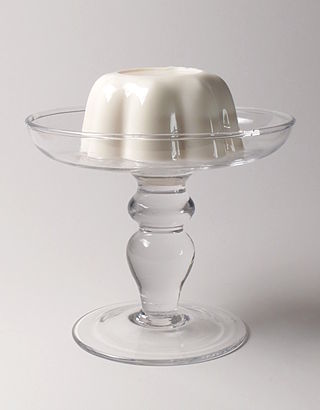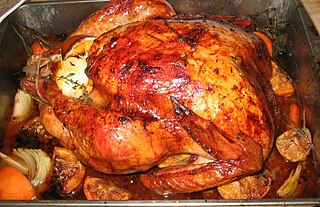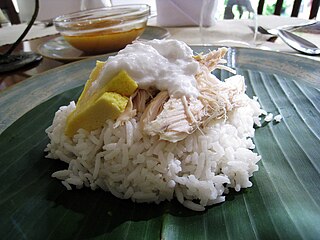
Turkish cuisine is the cuisine of Turkey and the Turkish diaspora. The cuisine took its current form after numerous cultural interactions throughout centuries, descending from earlier stages of Turkish cuisine, Ottoman cuisine and Seljuk cuisine. Turkish cuisine with traditional Turkic elements such as yogurt, ayran, kaymak, exerts and gains influences to and from Mediterranean, Balkan, Middle Eastern, Central Asian and Eastern European cuisines.

Blancmange is a sweet dessert popular throughout Europe commonly made with milk or cream and sugar, thickened with rice flour, gelatin, corn starch, or Irish moss, and often flavoured with almonds.

Pudding is a type of food. It can be either a dessert, served after the main meal, or a savoury dish, served as part of the main meal.

Puerto Rican cuisine consists of the cooking style and traditional dishes original to Puerto Rico. It has been primarily a fusion influenced by the ancestors of the Puerto Rican people: the indigenous Taínos, Spanish Criollos and sub-Saharan African slaves. As a territory of the United States, the culinary scene of Puerto Rico has also been moderately influenced by American cuisine.
Albanian cuisine is a representative of the cuisine of the Mediterranean. It is also an example of the Mediterranean diet based on the importance of olive oil, fruits, vegetables and fish. The cooking traditions of the Albanian people are diverse in consequence of the environmental factors that are more importantly suitable for the cultivation of nearly every kind of herbs, vegetables and fruits. Olive oil is the most ancient and commonly used vegetable fat in Albanian cooking, produced since antiquity throughout the country particularly along the coasts.

Rice pudding is a dish made from rice mixed with water or milk and commonly other ingredients such as sweeteners, spices, flavourings and sometimes eggs.

Kheer, also known as payasam or payesh, is a pudding or porridge popular in South Asia, usually made by boiling milk, sugar or jaggery, and rice. It can be additionally flavoured with dried fruits, nuts, cardamom and saffron. Instead of rice, it may contain cracked wheat, vermicelli (sevai), sago or tapioca (sabudana).

Tamil cuisine is a culinary style of Tamil people originating in the southern Indian state of Tamil Nadu and neighboring Sri Lanka. Meats, along with rice, legumes, and lentils, are popular. Dairy products and tamarind are used to provide sour flavors. On special occasions, traditional Tamil dishes are served in a traditional manner, using banana leaves in place of utensils. After eating, the banana leaves are then used as a secondary food for cattle. A typical breakfast meal consists of idli or dosa with chutney. Lunch includes rice, sambar, curd, kuzhambu, and rasam.

Christmas dinner is a meal traditionally eaten at Christmas. This meal can take place any time from the evening of Christmas Eve to the evening of Christmas Day itself. The meals are often particularly rich and substantial, in the tradition of the Christian feast day celebration, and form a significant part of gatherings held to celebrate the arrival of Christmastide. In many cases, there is a ritual element to the meal related to the religious celebration, such as the saying of grace.

Ottoman cuisine is the cuisine of the Ottoman Empire and its continuation in the cuisines of Greece, Turkey, the Balkans, Caucasus, Middle East and Northern Africa.
Hyderabadi cuisine, also known as Deccani cuisine, is the cooking style characteristic of the city of Hyderabad and its surrounding area in Telangana, India.

Coconut rice is a dish prepared by cooking white rice in coconut milk or coconut flakes. As both the coconut and the rice-plant are commonly found in the tropics all around the world, coconut rice, too, is found in many cultures throughout the world, spanning across the equator from Southeast Asia, the Indian subcontinent, South America, Central America, West Africa, East Africa, the Caribbean and Oceania.

Jordanian cuisine is a Levantine cuisine developed over time in Jordan. Stuffed vegetables are common, with many different techniques employed in their preparation. Meat is an important component of Jordanian cuisine, most often lamb, beef and chicken but also goat and camel meat. Rice is frequently served as a side dish but there are also one-pot rice dishes such as maqloubah.

Zarda is a traditional boiled sweet rice dish, native to the Indian subcontinent, made with saffron, milk and sugar, and flavoured with cardamom, raisins, pistachios or almonds. The name 'zarda' comes from Persian word 'zard' زرد meaning 'yellow', because the food coloring added to the rice gives it a yellow color. Zarda is typically served after a meal. In the Indian subcontinent, zarda was and still remains a popular dessert on special occasions such as weddings. It is quite similar to sholezard, a traditional Iranian dessert, and zerde, a traditional Turkish dessert.

Meghli, moghli, meghleh,, or karawiyah, is a Levantine dessert based on a floured rice pudding and spiced with anise, caraway, and cinnamon. The dish is often garnished with dried coconut flakes and various nuts including almonds, walnuts, pine nuts, and pistachios. Meghli is commonly served to celebrate the birth of a child. It is also a popular Christmas dessert in Lebanon as a celebration of the birth of Jesus.

Muhallebi is a milk pudding commonly made with rice, sugar, milk and either rice flour, starch or semolina, popular as a dessert in the Middle East. While the dessert is called Muhallebi in Turkey and Iraq, the Egyptian variant is called mahalabia and the Levantine variant, common in Jordan, Lebanon, Palestine and Syria, is called mahalabiyeh.

Mango sticky rice is a traditional Southeast Asian and South Asian dessert made with glutinous rice, fresh mango and coconut milk, and eaten with a spoon or the hands.

Kue lapis is an Indonesian kue, or a traditional snack of steamed colourful layered soft rice flour pudding. In Indonesian, lapis means "layers". This steamed layered sticky rice cake or pudding is quite popular in Indonesia, Suriname and can also be found in the Netherlands through their colonial links.
















